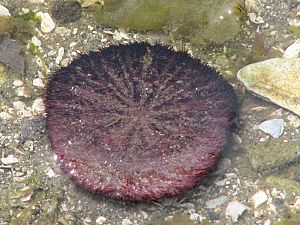Sand dollar facts for kids
Quick facts for kids Sand dollar |
|
|---|---|
 |
|
| Living sand dollars look rather different from the white tests found on the beach. |
|
| Scientific classification | |
| Domain: | |
| Kingdom: | |
| Phylum: | |
| Class: | |
| Superorder: |
Gnathostomata
|
| Order: |
Clypeasteroida
|
The Sand dollars are species of flattened, burrowing sea urchins belonging to the order Clypeasteroida. Echinarachnius parma, the Common Sand Dollar, is widespread in the Northern Hemisphere, from the intertidal zone to considerable depths. Sand dollars can be found in temperate and tropical zones, but not in Great Britain.p76
All sand dollars have a rigid skeleton known as a test. This is the typical white disk found washed up on beaches. The living animals have a skin of movable spines on the test. Movement is done by the action of the spines. Like other sea urchins, sand dollars have five paired rows of pores. The pores are arranged in a petal-like pattern. These pores are perforations in the endoskeleton through which the tube feet, used in gas exchange, project from the body.
Contents
Description
Living sand dollars have small spines covering its entire body. They are softer and much shorter than those of the sea urchin. Like all echinoderms, sand dollars have tube feet. They are not used to move around, but simply to breathe. The sand dollar's tube feet actually stick out of the top of the sand dollar. On a sand dollar test, there is usually a pattern that looks like the petals of a flower. That pattern is made up of many tiny holes, and it is through these holes that the sand dollar's tube feet came out when it was alive.
A sand dollar uses its tiny spines to move around, and to dig into the sand. It often does this to bury itself in the sand. Sometimes, a sand dollar will only partially bury itself in the sand, and ends up poking up from the sand, standing on its side.
On the underside of a sand dollar, there is a star pattern spreading out from the center where the mouth is. This star pattern is made up of grooves that are called food grooves. Sand dollars filter sand and water, catching plankton and other things on their spines. Then, with cilia, the spines move the food into a food groove, and the food travels down the food groove to the mouth. Its food consists of crustacean larvae, small copepods, diatoms, algae and detritus.
Life style
The sand dollars are the most specialised sea urchins. All their features are adaptations for burrowing. They live just beneath the sand, either flat or at an angle. At an angle they keep the edge facing the oncoming currents, presumably to catch food. This excellent habitat has been taken up by other groups of sea urchins. The heart urchins, another order, are even more effective in burrowing.p76 Sand dollars can live for up to 10 years.
Colours
Most living sand dollars have dark colours, like brown or purple. Their darker color helps them stay camouflaged, easily hiding in the sand or mud or on the sea floor. The tests of sand dollars do not have bristles and tube feet, and because of the sun, they usually become bleached white.
Images for kids
-
Leodia sexiesperforata by Louis Agassiz (1841)
-
Encope emarginata (aboral and oral faces) by Ernst Haeckel (1904)
-
Clypeaster rosaceus (aboral and oral faces) by Ernst Haeckel (1904)
-
Eccentric sand dollars (Dendraster excentricus) at Monterey Bay Aquarium.
-
Sand dollar beneath the sand at low tide on Hilton Head Island
-
Live sea biscuit, Clypeaster rosaceus, commonly found off Key Biscayne, Florida
See also
 In Spanish: Clipeasteroides para niños
In Spanish: Clipeasteroides para niños

















